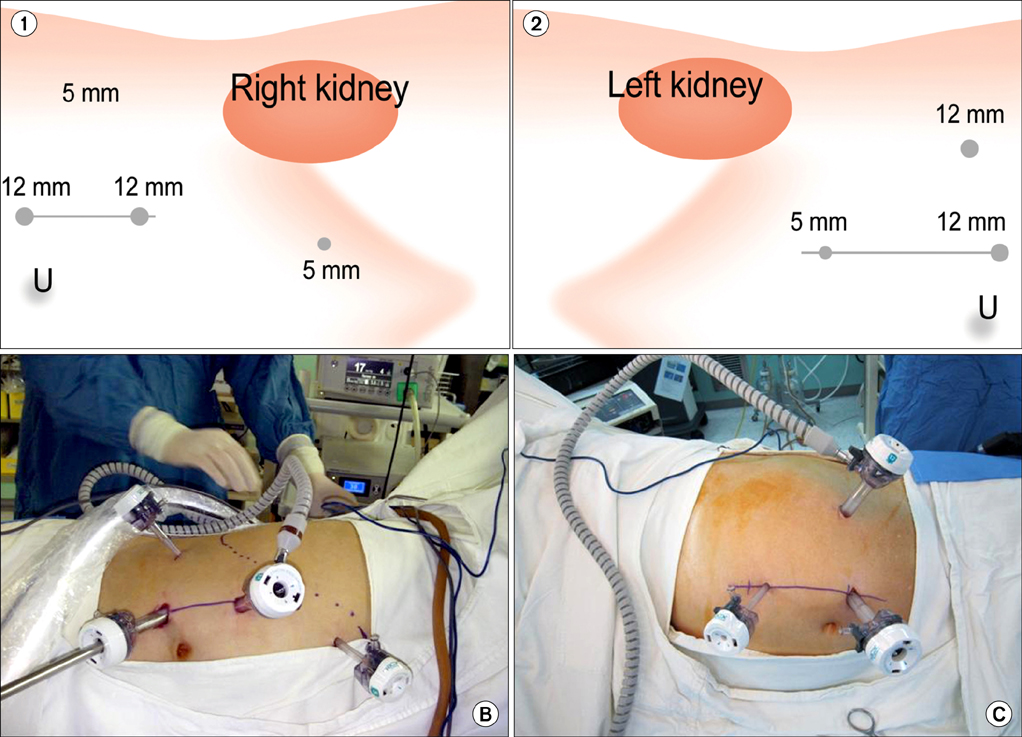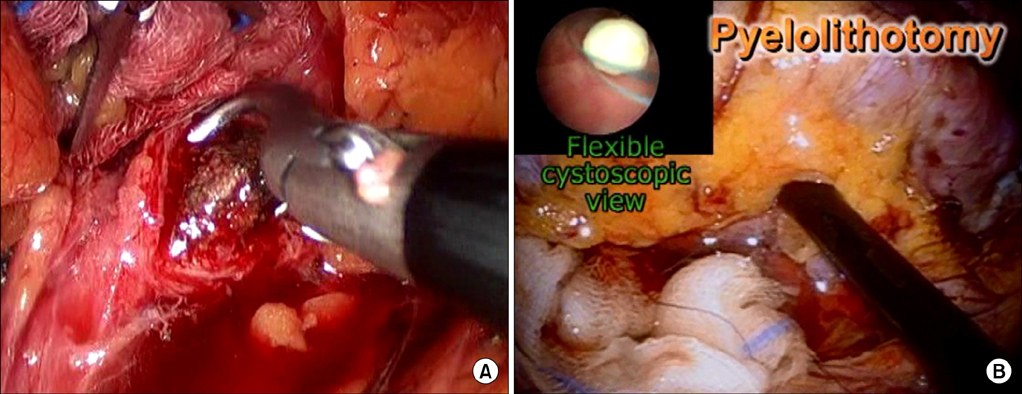Korean J Urol.
2014 Jul;55(7):475-481. 10.4111/kju.2014.55.7.475.
Laparoscopic Stone Surgery With the Aid of Flexible Nephroscopy
- Affiliations
-
- 1Department of Urology, Seoul National University Hospital, Seoul, Korea.
- 2Department of Urology, SMG-SNU Boramae Medical Center, Seoul, Korea. urseungbaelee@gmail.com
- 3Department of Urology, Eulji University School of Medicine, Daejeon, Korea.
- KMID: 1794577
- DOI: http://doi.org/10.4111/kju.2014.55.7.475
Abstract
- PURPOSE
To report the outcome of laparoscopic pyelo- and ureterolithotomies with the aid of flexible nephroscopy.
MATERIALS AND METHODS
A retrospective analysis was performed in 71 patients with complex renal stones or large and impacted proximal ureteral stones. Patients underwent laparoscopic pyelo- or ureterolithotomies with or without the removal of small residual stones by use of flexible nephroscopy between July 2005 and July 2010. Operative success was defined as no residual stones in the intravenous pyelogram at 12 weeks postoperatively. Perioperative results and surgical outcomes were analyzed.
RESULTS
The patients' mean age was 54.7+/-13.7 years, and 53 males (74.6%) and 18 females (25.4%) were included. The mean maximal stone size was 19.4+/-9.4 mm. A total of 47 cases were complex renal stones and 24 cases were impacted ureteral stones. Mean operative time was 139.0+/-63.7 minutes. Stones were completely removed in 61 cases (85.9%), and no further ancillary treatment was needed for clinically insignificant residual fragments in 7 cases (9.9%). For complex renal stones, the complete stone-free rate and clinically significant stone-free rate were 80.9% and 93.6%, respectively. Multivariate analysis showed that the use of flexible nephroscopy for complex renal stones can reduce the risk of residual stones. A major complication occurred in one case, in which open conversion was performed.
CONCLUSIONS
Laparoscopic stone surgery is a safe and minimally invasive procedure with a high success rate, especially with the aid of flexible nephroscopy, and is not associated with procedure-specific complications.
Keyword
MeSH Terms
Figure
Reference
-
1. Lam HS, Lingeman JE, Mosbaugh PG, Steele RE, Knapp PM, Scott JW, et al. Evolution of the technique of combination therapy for staghorn calculi: a decreasing role for extracorporeal shock wave lithotripsy. J Urol. 1992; 148(3 Pt 2):1058–1062.2. Lam HS, Lingeman JE, Barron M, Newman DM, Mosbaugh PG, Steele RE, et al. Staghorn calculi: analysis of treatment results between initial percutaneous nephrostolithotomy and extracorporeal shock wave lithotripsy monotherapy with reference to surface area. J Urol. 1992; 147:1219–1225.3. Assimos DG, Boyce WH, Harrison LH, McCullough DL, Kroovand RL, Sweat KR. The role of open stone surgery since extracorporeal shock wave lithotripsy. J Urol. 1989; 142(2 Pt 1):263–267.4. Paik ML, Wainstein MA, Spirnak JP, Hampel N, Resnick MI. Current indications for open stone surgery in the treatment of renal and ureteral calculi. J Urol. 1998; 159:374–378.5. Marickar YM, Nair N, Varma G, Salim A. Retrieval methods for urinary stones. Urol Res. 2009; 37:369–376.6. Salvado JA, Guzman S, Trucco CA, Parra CA. Laparoscopic pyelolithotomy: optimizing surgical technique. J Endourol. 2009; 23:575–578.7. Skolarikos A, Papatsoris AG, Albanis S, Assimos D. Laparoscopic urinary stone surgery: an updated evidence-based review. Urol Res. 2010; 38:337–344.8. Desai RA, Assimos DG. Role of laparoscopic stone surgery. Urology. 2008; 71:578–580.9. Simforoosh N, Basiri A, Danesh AK, Ziaee SA, Sharifiaghdas F, Tabibi A, et al. Laparoscopic management of ureteral calculi: a report of 123 cases. Urol J. 2007; 4:138–141.10. Ko YH, Kang SG, Park JY, Bae JH, Kang SH, Cho DY, et al. Laparoscopic ureterolithotomy as a primary modality for large proximal ureteral calculi: comparison to rigid ureteroscopic pneumatic lithotripsy. J Laparoendosc Adv Surg Tech A. 2011; 21:7–13.11. Preminger GM, Assimos DG, Lingeman JE, Nakada SY, Pearle MS, Wolf JS Jr, et al. Chapter 1: AUA guideline on management of staghorn calculi: diagnosis and treatment recommendations. J Urol. 2005; 173:1991–2000.12. Ramakumar S, Lancini V, Chan DY, Parsons JK, Kavoussi LR, Jarrett TW. Laparoscopic pyeloplasty with concomitant pyelolithotomy. J Urol. 2002; 167:1378–1380.13. Gaur DD, Trivedi S, Prabhudesai MR, Gopichand M. Retroperitoneal laparoscopic pyelolithotomy for staghorn stones. J Laparoendosc Adv Surg Tech A. 2002; 12:299–303.14. Sampaio FJ. Surgical anatomy of the kidney. In : Smith AD, Preminger G, Badlani G, Kavoussi L, editors. Smith's text book of endourology. St. Louis: Quality Medical;1996. p. 153–184.15. Chatham JR, Dykes TE, Kennon WG, Schwartz BF. Effect of percutaneous nephrolithotomy on differential renal function as measured by mercaptoacetyl triglycine nuclear renography. Urology. 2002; 59:522–525.16. Moskovitz B, Segev Y, Sopov V, Horev N, Groshar D, Nativ O. Does percutaneous nephrolithotripsy (PCNL) affect renal function: assessment with quantitative spect of Tc 99M-DMSA (QDMSA) renal scintigraphy. Harefuah. 2005; 144:626–629. 67667717. Liou LS, Streem SB. Long-term renal functional effects of shock wave lithotripsy, percutaneous nephrolithotomy and combination therapy: a comparative study of patients with solitary kidney. J Urol. 2001; 166:36.18. Kurien A, Baishya R, Mishra S, Ganpule A, Muthu V, Sabnis R, et al. The impact of percutaneous nephrolithotomy in patients with chronic kidney disease. J Endourol. 2009; 23:1403–1407.19. El-Tabey NA, El-Nahas AR, Eraky I, Shoma AM, El-Assmy AM, Soliman SA, et al. Long-term functional outcome of percutaneous nephrolithotomy in solitary kidney. Urology. 2014; 83:1011–1015.20. Sharifiaghdas F, Kashi AH, Eshratkhah R. Evaluating percutaneous nephrolithotomy-induced kidney damage by measuring urinary concentrations of β2-microglobulin. Urol J. 2011; 8:277–282.21. Bayrak O, Seckiner I, Erturhan SM, Mizrak S, Erbagci A. Analysis of changes in the glomerular filtration rate as measured by the cockroft-gault formula in the early period after percutaneous nephrolithotomy. Korean J Urol. 2012; 53:552–555.22. Demirtas A, Caniklioglu M, Kula M, Sofikerim M, Akınsal EC, Ergul MA, et al. Assessment of the effects of access count in percutaneous nephrolithotomy on renal functions by technetium-99m-dimercaptosuccinic Acid scintigraphy. ISRN Urol. 2013; 2013:827121.23. Matsuura H, Hioki T, Sakurai M, Arima K, Yanagawa M, Sugimura Y, et al. Influence of extracorporeal shock wave lithotripsy (ESWL) on renal function assessed by 99mTc-DMSA scintigraphy: comparative analysis between ESWL and percutaneous nephroureterolithotripsy (PNL). Hinyokika Kiyo. 1994; 40:1061–1067.24. Yasui T, Okada A, Hamamoto S, Taguchi K, Ando R, Mizuno K, et al. Efficacy of retroperitoneal laparoscopic ureterolithotomy for the treatment of large proximal ureteric stones and its impact on renal function. Springerplus. 2013; 2:600.25. Wang X, Li S, Liu T, Guo Y, Yang Z. Laparoscopic pyelolithotomy compared to percutaneous nephrolithotomy as surgical management for large renal pelvic calculi: a meta-analysis. J Urol. 2013; 190:888–893.26. Stein RJ, Turna B, Nguyen MM, Aron M, Hafron JM, Gill IS, et al. Laparoscopic pyeloplasty with concomitant pyelolithotomy: technique and outcomes. J Endourol. 2008; 22:1251–1255.27. Nadu A, Schatloff O, Morag R, Ramon J, Winkler H. Laparoscopic surgery for renal stones: is it indicated in the modern endourology era? Int Braz J Urol. 2009; 35:9–17.28. Gill IS, Grune MT, Munch LC. Access technique for retroperitoneoscopy. J Urol. 1996; 156:1120–1124.29. Bove P, Micali S, Miano R, Mirabile G, De Stafani S, Botteri E, et al. Laparoscopic ureterolithotomy: a comparison between the transperitoneal and the retroperitoneal approach during the learning curve. J Endourol. 2009; 23:953–957.
- Full Text Links
- Actions
-
Cited
- CITED
-
- Close
- Share
- Similar articles
-
- Laparoscopic Surgery for Common Bile Duct Stone
- Efficacy of Laparoscopic Ureterolithotomy for the Upper Ureter Stone
- Effectiveness of Flexible Ureteroscopic Stone Removal for Treating Ureteral and Ipsilateral Renal Stones: A Single-Center Experience
- Evaluation of the effect of Bernoulli maneuver on operative time during mini-percutaneous nephrolithotomy: A prospective randomized study
- Common Bile Duct Stone Caused by Migrated Surgical Clip 10 Years after Laparoscopic Cholecystectomy



